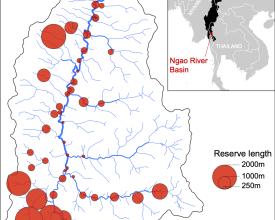Grassroots reserves have strong benefit for river ecosystems in the Salween River Basin

Throughout Southeast Asia, in response to perceived declines in fish populations, concerns for continued resource security, and encroachment from outsiders using illegal fishing gear (e.g. electric shocking), small no-take reserves on rivers have been created by local communities, established by non-governmental organisations or imposed by national governments. These small reserves are effectively the only management action for these intensive-harvest fisheries. In tributaries of the Salween River in north-western Thailand, ecological networks of small riverine reserves continue to grow, particularly among fishery-dependent communities where overharvest is common.
Impacts
There is no broad strategic planning among communities regarding the creation of reserves. In fact, there is a general lack of recognition even among community members of the number of reserves in existence throughout the Mae Ngao River Basin, a tributary of the Salween. Nevertheless, there are now 52 reserves that, basin-wide, cover 2% of all perennially flowing water, and form a network of protected areas within the larger river network. This network has been entirely created and enforced by individual communities.
Intense fishing creates a large barrier to connectivity between and among reserves. Viewed at more local scales, though, individual reserves are typically large enough to connect habitats within the river network, including pools that are critical refugia for many species during dry season.
A comparison of 23 of these small reserves with adjacent fished areas showed gains in fish species richness, density and biomass commensurate with reported gains from marine reserves. Specifically, richness increased in reserves relative to fished areas by 27% and density by 124%, and biomass was 23 times higher on average.
However, it remains unclear whether reserves are sufficiently large to maintain populations over the long term and whether there is regular movement among reserves that would transfer critical genetic diversity among potentially isolated sub-populations.




